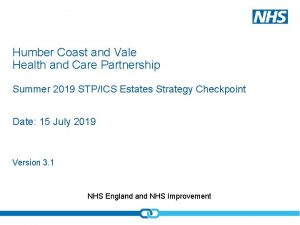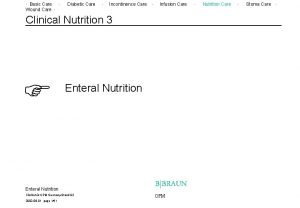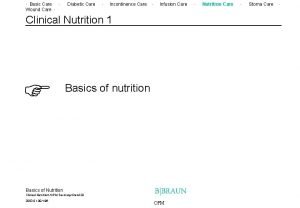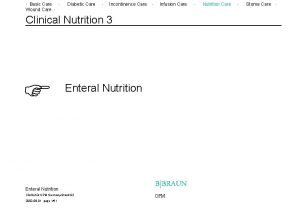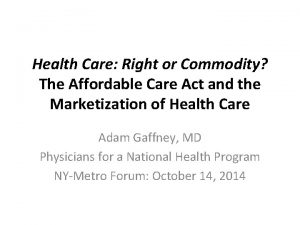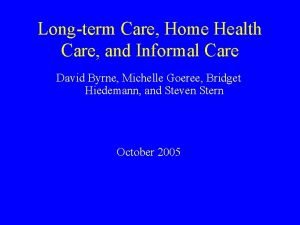Right to Health and Right to Health Care












- Slides: 12

Right to Health and Right to Health Care: Building a strategy for Intervention by Peoples Movements: TEN STATEMENTS PRESENTATION AT NATIONAL WORKSHOP OF ALL INDIA PEOPLES SCIENCE NETWORK WITH JAN VIGYANA VEDIKA, TELENGANA DECEMBER 21 -22 , 2019

1. The Mandate The Indian government is already committed to achieving the right to health and right to healthcare and should be held accountable to this commitment. We should neither forget, nor let government ignore or distract us from this commitment. ” “ International: UNDHR, ICESCR, Health for All, CEDAW, National : Supreme Court Rulings, Policy.

2. We need to learn from past efforts at making health and healthcare into a justiciable right in India and in other nations: International-most industrialized nations + Cuba, Thailand, Brazil, South Africa. There have been past moves to pass such an Act in India during NRHM peak- and one state (Assam) has actually passed such an act Assam. Also learn from experience of Right to Education. ? Some key issues: 1. State act or central act? 2. Right to Health or Right to health care? 3. Public Provisioning based or could it depend on insurance/PPPs

3. There are essential political conditions for the realization of the right to health and healthcare Present political conditions are not favorable to an Act. We need: u Peace at the borders, u diminished internal conflict, u a commitment to federalism, ua commitment to a welfare state, and the states role in public services u a commitment to equity and sustainability in all development policies. For a health activist- the campaign for right to health act is where they engage with the political conditions required for an Act. .

4. There is a need for a Peoples Road Map for Universal Health Care: : “ 1. Assures equity in access to all health services not just selective packages -only important exclusions. 2. Ensure that universal healthcare is build around robust, good quality, universalized public health services playing the dominant role in healthcare delivery. Should NOT become effort to stigmatize public services, and equate universal health coverage (as different from care) with insurance mechanisms and strategic purchasing: 3. Rights can be enforced only with public providers. 4. Market logic built around commodification (exchange value dominates) but to realize it as a right it has to be produced at terms where it is a” gift” – where only use value matters-. 5. If model is “purchasing” based - in combination with corporate pressures and judiciary rulings, used to include costlier packages of care into insurance packages: Without a broad consensus on the road- map there are dangers of RTH Act being used to drive privatization and regulatory regimes that serve corporate interests- and eliminate affordable care.

5. A Campaign for Right to Healthcare is an essential condition for saving and strengthening public health systems: 1. The right to healthcare can be enforced only with public providers. In Indian jurisprudence, with private sector one can ask for enforcing contracts- but can one enforce rights to a service. Examples from NHRC and case law 2. Since in most rural and remote areas and in under-serviced and marginalized populations, private providers do not operate a right to health care law would force governments to provide services to these sections. This has been the experience in many nations like Brazil and Thailand 3. Even as we fight against weaknesses of public services, we need to fight stigmatization of public services- and prevent weaknesses from being used as justification for privatization. . . …. But we would need a political window of opportunity to enact such a law. .

6. The Right to Health and Healthcare Campaign could become a broad-based unifying platform for action in such divisive times as this. This is an achievable goal : can attract many sections : health professionals, healthcare providers, students; employees , working peoples, women Can cut across many divides and help reach into many “echo-chambers” Help us learn how to negotiate social media and organize new sections. The campaign for right to healthqwill have a large component on health education: addresses individuals/families qwill push for the direction of reforms we want- as opposed to market based reforms. qwill necessarily address the political conditions required for the right to health.

7. The main objective of this campaign would be to shape the public discourse for the right to health and build consensus on a road map to achieve this. “The main objective of this campaign would be to shape the public understanding of what is required for the right to health and right to healthcare and propose a road map to achieve this. ” This includes “citizenship” : “ One doesn’t ask of one who suffers: what is your country and what is your religion? One merely says: you suffer, this is enough for me, you belong to me and I shall help you. ” Louis Pasteur : It also includes the fight for federalism and for the welfare state— It also includes building understanding on what is required for health systems strengthening. . collateral objective: contest the dominant discourse imposed by international health agencies and large sections of international academic community, which legitimizes and facilitates shaping health services as vehicles for corporate profits- usually on the lines of the US healthcare system. Collateral objectives – organizational- development of capacity and of networks

8. AIPSN and JSA have Complementary roles- catalysts and leadership This campaign would by AIPSN and its member organizations in partnership with the Jan Swasthya Abhiyan of which the AIPSN is a founder and an active constituent. The participation of the AIPSN with large membership among school and college teachers, students, and working people, gives its an opportunity to take this campaign to many new sections. Membership based, self-financed, independently decided agenda, nature of networking different. They also bring along a distinct broad political perspetive The JSA is a major source of both resource persons and fraternal organizations. Many NGOs who work with us may have different priorities due to the nature of funding support that is available to them. Many NGOs are Employee-Based, Externally funded, with pressures on agenda, Most welcome working with PSMs and their potential mass-movement linkages. Because PSMs are membership based and raise resources in a decentralized way, they should be able to set their own agenda much better. But what would limit PSMs is the lack of capacity to do so.

9. State Specific Content - and in state language: Develop PSM understanding, at the state level ON 1 Main causes of ill health in state population- contest selective healthcare: 2 Social determinants of the above causes: and what collective action can do about it 3 Organization of Health Services & Human resources : and what are peoples demands on this 4 Gender equity & equity in health and health care, 5 Access to medicines : also patents and trade 6 Medical and Health care Education 7 Nutrition, 8 Environment and Occupational Health Means the development number of booklets or papers @ development of a resource team

10. Outlines of a state activity plan I. Creating resource persons in the district level ◦ who would be PSM members, ◦ Who would be earning from their respective jobs, but working “voluntarily” to take forward the discourse Functions of the Resource team : Take this discourse into (a) work places (b) local communities (c)local media channels and (d) social media groups. ◦ Bulk of messaging would be educational and focus on what local communities and families can do to safeguard their health. (This also would needs its own content and media development) ◦ In addition – some 20% of messaging must also include political – counter divisive and dangerous narratives. ◦ Learn to reach into other echo-chambers- that is an important goal in itself> II. Within the health sector: Create a discourse and a network of resource persons: That can save and strengthen public health services: Oppose dominant narratives that legitimize privatisation, or mis-direct efforts at strengthening public services

Thank you
 Right product right place right time right price
Right product right place right time right price Right time right place right quantity right quality
Right time right place right quantity right quality Primary, secondary, tertiary care
Primary, secondary, tertiary care Unit 2 equality diversity and rights
Unit 2 equality diversity and rights Health and social care component 3
Health and social care component 3 The right man on the right place at the right time
The right man on the right place at the right time West yorkshire and harrogate health and care partnership
West yorkshire and harrogate health and care partnership Humber, coast and vale health and care partnership
Humber, coast and vale health and care partnership Appraisal in health and social care
Appraisal in health and social care Sam and verna williams
Sam and verna williams Duty of care care certificate
Duty of care care certificate Acul magnetic al unei busole se orienteaza
Acul magnetic al unei busole se orienteaza Palliative care versus hospice care
Palliative care versus hospice care







